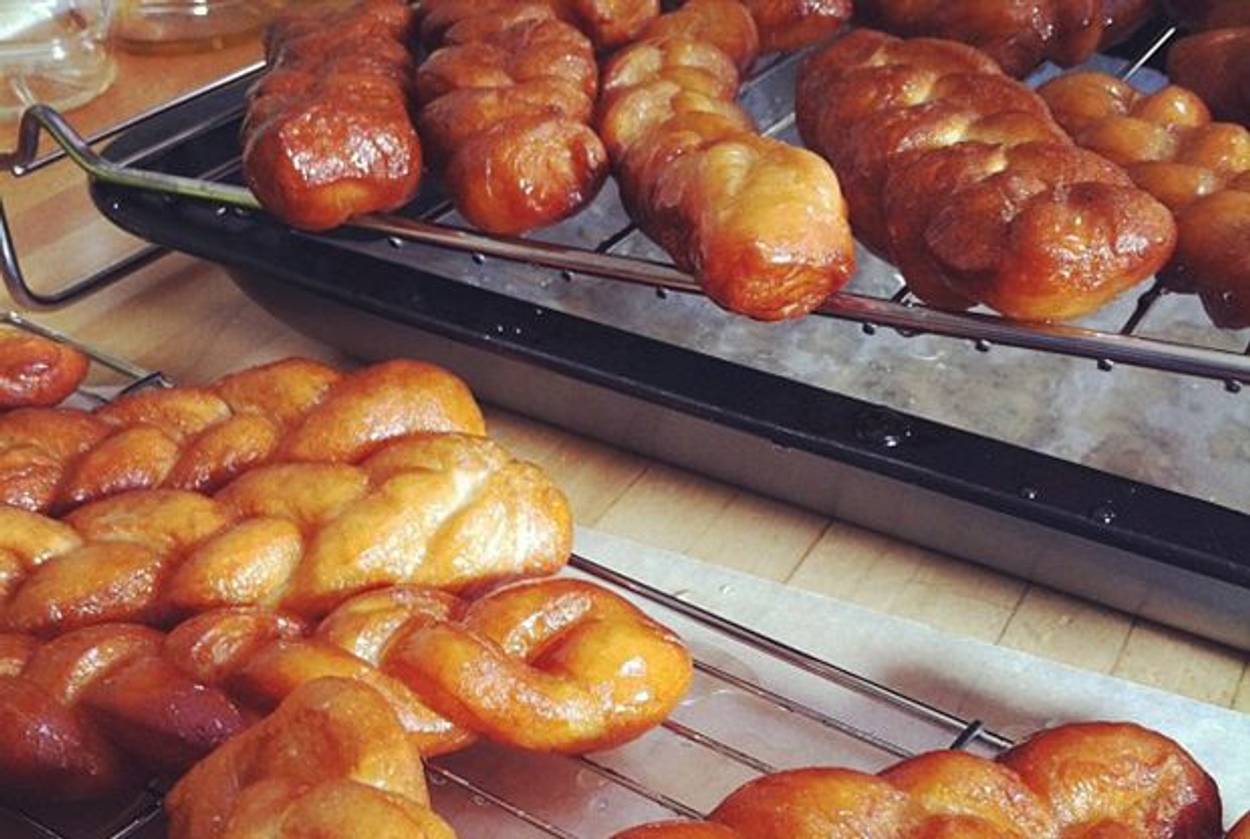A Dessert for the Hanukkah-Christmas Eclipse
Meet the koeksister, a South African cookie




Today’s a special day. It’s both Hanukkah and Christmas Eve, a double yontef where two great culinary traditions, the donut and the sugar cookie, overlap like a calorie-laden eclipse. But why have just one or the other when you can literally have both in the same pastry? Enter the koeksister (pronounced “cook-sister”), a traditional South African sweet that is both a donut and a cookie. Koeksisters are little braided doughs that are fried till golden brown, then immersed in sugary syrup. (Best not to spend too much time pondering their nutritional content.) They’re decadent, fun to make, and delicious enough to momentarily rob you of speech.
I experienced this firsthand when I sampled my very first koeksister at the home of the Cohen family in Wynnewood, PA on Saturday. Brian Cohen, a math teacher living in Brooklyn (and a friend from Friday night services), had invited me to his childhood home to participate in one of his family’s long-standing holiday traditions: making koeksister cookies on Hanukkah.
The idea originated with Brian’s mother, South African-born geneticist Adele Schneider, who was looking for something fun for her three kids to do on the holiday that wasn’t centered around giving gifts, which isn’t a Hanukkah tradition in most Jewish communities outside the U.S. So about 20 years ago the koeksister-making tradition was born, “and it morphed into this big annual party,” she said, gesturing at the packed kitchen. Altogether, about 50 family members and friends gathered for cookie-making, menorah-lighting, and a vegetarian Indian buffet dinner. (The choice of cuisine, too, is a nod to South Africa, which is home to a big South Asian diaspora.) “It’s a very fun thing, and because koeksisters require a lot of work, we need a lot of people to do it,” said Adele. And (of course) they’re fried.
Some of the guests were first-timers like me, others had been coming for years. As we braided, fried, and ate, we shared stories and typical small talk. Liz Barone, Brian’s teaching mentor, told me about how her family escaped the Armenian genocide and found their way to America. (Like many stories of Holocaust survival, it was one of quick thinking, tenacity, and sheer good luck.) Brian’s father, Montreal-born chemist Gordon Cohen, told me about growing up in the Canadian Jewish community. Rebecca Kass, one of Brian’s old roommates from Moishe House in Philadelphia, explained that she acquired a taste for the cookies when they made them one year at the Jewish residence. Friends of Brian’s siblings arrived in a steady stream. The kitchen was crowded but jolly, and people switched between the braiding, frying, and dipping stations. Carol Lowe, a South African-born family friend, told me about the different varieties of koeksisters—we made the sweet Afrikaner kind, but the Cape Malay koeksisters are more like traditional sufganiyot, dusted with spices and coconut.
As Schneider and Lowe both pointed out, Koeksisters aren’t Jewish in origin, but I’m fully prepared to convert them to the tribe. Not only are they a perfect Hanukkah (or Hanukkah-Christmas-eclipse) dessert, making them is super-Jewy culinary experience. First, you prepare a buttery scone-like dough in the food processor, the most Jewish kitchen appliance of all time. Then you set the dough aside to rise and braid it into dozens of tiny challah shapes. Then you fry the dough (frying, along with barbecuing and pickling, is one of the three patriarchs of Jewish food prep). Lastly, you dip the fried braids in sugar-syrup, and y’all know how much Jews love to dip things (and talk about dipping things). Like a lot of Jewish rituals, it’s a lengthy and labor-intensive process.
But then, finally, you have a sublime cookie: warm, soft, and buttery on on the inside; crisp and sweet on the outside. When I took my first bite, I glanced at a woman across the dining room table doing the same. Eyes widened, we wordlessly smiled and nodded at each other, pointing at our koeksisters in a universal gesture of appreciation: How great is this?
(The exact Schneider-Cohen family recipe can not be disclosed, but here’s one that is similar.)
Elissa Goldstein is Tablet’s director of audience development. She also produces Unorthodox. Follow her on Twitter here.